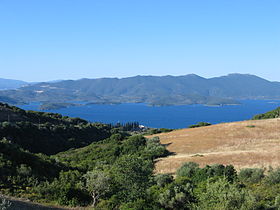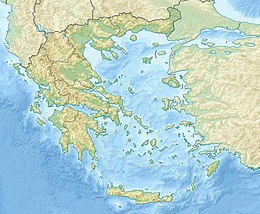Pelion
| Pelion | |
|---|---|
|
Πήλιο Pilio |
|
 |
|
| Highest point | |
| Elevation | 1,610 m (5,280 ft) |
| Prominence | 1,473 m (4,833 ft) |
| Listing | Parkland |
| Coordinates | 39°26′19″N 23°2′47″E / 39.43861°N 23.04639°ECoordinates: 39°26′19″N 23°2′47″E / 39.43861°N 23.04639°E |
| Naming | |
| Pronunciation | Greek: [ˈpiʎo] |
| Geography | |
| Location | Larissa regional unit, Greece |
| Parent range | Pilio |
| Geology | |
| Mountain type | Fold |
| Climbing | |
| Easiest route | road, climb |
Pelion or Pelium (Modern Greek: Πήλιο, Pílio; Ancient Greek/Katharevousa: Πήλιον. Pēlion) is a mountain at the southeastern part of Thessaly in central Greece, forming a hook-like peninsula between the Pagasetic Gulf and the Aegean Sea. Its highest summit, Pourianos Stavros, is 1,610 metres (5,280 ft) amsl. The Greek National Road 38 (GR-38) runs through the southern portion of the peninsula and GR-38A runs through the middle.
The mountain is thickly forested, with both deciduous and perennial forests, mainly of beech, oak, maple and chestnut trees, with plane tree groves surrounding places with water. Pelion is considered one of the most beautiful mountains in Greece and is a popular tourist attraction throughout the year: hiking trails and stone paths give access to springs, coves and numerous beaches, sandy or pebbly, set among lusciously green slopes. Pelion is an amply watered mountain with an abundance of springs, gorges, streams and rivulets; many streams are routed in carved-stone artificial beds to bring water to the villages and their thriving orchards. The higher elevations of the mountain receive enough snowfall so as to host skiing facilities that operate from Christmas to Easter.
Pelian cuisine specializes in charcuterie, its most famed dish being spentzofáï, a hearty stew made of sliced pork sausage that is first cooked on its own, then stewed with green and red peppers, mild or hot as the case may be, and shallots or small onions; eggplant or tomatoes are added when seasonally available. Pelion is also renowned for its orchard fruit, with pride of place going to the firíki, an originally Egyptian apple varietal of very small, oval-shaped, intensely fragrant, crisp and slightly tart apples that withstand long storage without refrigeration. There is also wide cultivation of plums, especially mirabelles and greengages.
...
Wikipedia

